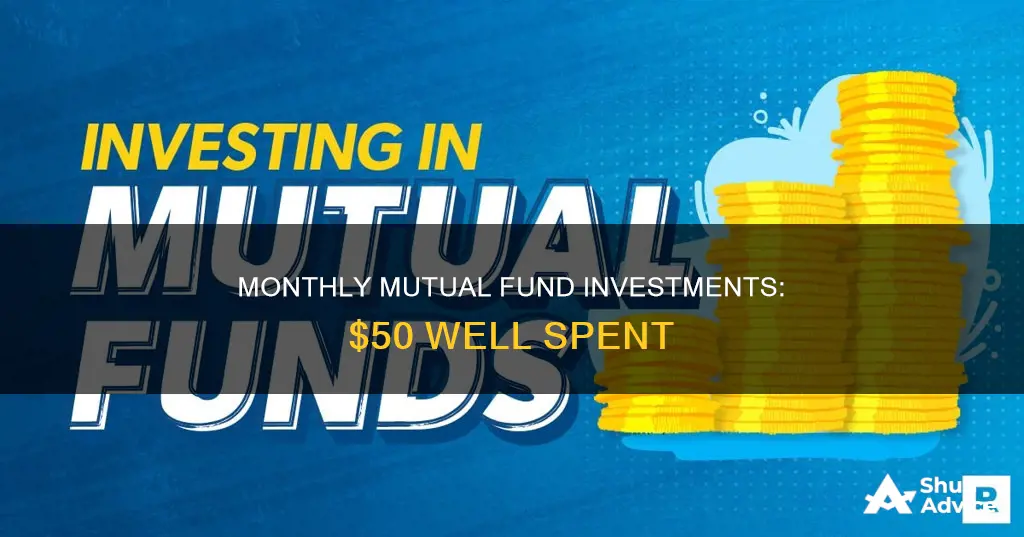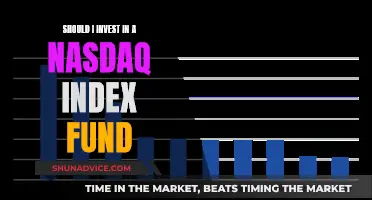
Investing $50 a month can be a great way to build wealth over time. While it may not seem like a significant amount, the power of compound interest means that your savings can grow into a substantial sum over the long term.
There are a few things to consider when investing with a small amount of money. Firstly, it is important to start investing early to take advantage of compound interest. Secondly, it is crucial to choose the right investment account and ensure that it aligns with your financial goals. Retirement accounts, such as IRAs and 401(k)s, offer tax advantages that can boost your savings. Thirdly, when investing with a small amount, it is essential to consider the fees and charges associated with different investment options. Index funds, mutual funds, and ETFs often have low fees, making them attractive options for those starting with a small investment. Finally, diversification is key to reducing risk and maximising returns.
By following these considerations, you can make the most of your $50 monthly investment and work towards achieving your financial goals.
| Characteristics | Values |
|---|---|
| Minimum Investment Amount | $50 per month |
| Additional Fees | May apply |
| Investment Options | Individual stocks, index funds, mutual funds, ETFs, real estate |
| Investment Accounts | Retirement accounts, taxable accounts, brokerage accounts, IRAs, 401(k)s |
| Investment Timeframe | Long-term (e.g., for retirement) |
| Investment Strategy | Dollar-cost averaging, automatic purchase plans, compound interest |
| Risk Factors | Volatility, market fluctuations, high-interest debt |
| Robo-Advisors | Wealthfront, Acorns |
What You'll Learn

Choose a platform that lets you invest with small amounts
When choosing a platform to invest your $50 a month, there are a few things to consider. Firstly, you'll want to look for a platform with low fees, as these can eat into your returns. Some platforms offer zero-fee investing, which is ideal for smaller investment amounts. You'll also want to consider the minimum investment requirements of different platforms and funds. Some mutual fund companies have high account minimums, but there are also many that allow you to get started with $50 or less. For example, Thrivent offers a mutual fund with a $50 minimum investment.
Another thing to consider is the level of risk you're comfortable with. If you're looking for a more hands-off approach, a robo-advisor might be a good option. Robo-advisors will ask you a few simple questions about your goals and risk tolerance and then invest your money in a diversified portfolio of index funds, mutual funds, and/or bond funds. They use algorithms to continually rebalance your portfolio and optimize it for taxes. While robo-advisors charge an annual fee, it's usually a small percentage of your balance.
If you're comfortable doing your own research and selecting investments, you might want to consider a brokerage account. Brokerages like Robinhood offer commission-free trading and the ability to invest in fractional shares, which can be a great way to diversify your portfolio when you're starting with a small amount of money.
Finally, don't forget to consider the tax implications of your investments. Retirement accounts like IRAs and 401(k)s offer tax advantages that can boost your returns. For example, with a Roth IRA, you pay taxes on your contributions today and then can withdraw your money tax-free in retirement.
Key Factors to Consider Before Investing in Mutual Funds
You may want to see also

Understand the different types of investment accounts
There are several types of investment accounts, each with its own purpose, eligibility requirements, and investment options. Here are some of the most common types of investment accounts:
- Standard Brokerage Account: Also known as a taxable brokerage account or non-retirement account, this type of account offers access to a wide range of investments, including stocks, mutual funds, bonds, and exchange-traded funds (ETFs). Any interest, dividends, or gains made are subject to taxes in the year they are received. You can choose between a cash account, which is suitable for most investors, and a margin account, which allows you to borrow money from the broker to invest but is riskier. There are no contribution limits, and money can be withdrawn at any time, though you may owe taxes on gains.
- Retirement Accounts: These include traditional IRAs (Individual Retirement Accounts) and Roth IRAs, as well as employer-sponsored plans like 401(k)s and 403(b)s. Retirement accounts offer similar investment options to standard brokerage accounts but provide tax advantages. With a traditional IRA, contributions may be tax-deductible, and taxes are paid upon withdrawal in retirement. With a Roth IRA, you contribute after-tax money, and withdrawals in retirement are tax-free. Retirement accounts may have contribution limits and early withdrawal penalties.
- Investment Accounts for Kids: These include custodial brokerage accounts, such as UGMA (Uniform Gift to Minors Act) and UTMA (Uniform Transfers to Minors Act) accounts, which allow adults to gift money to minors. The money is transferred to the child when they reach the age of majority (18 or 21, depending on the state). Another option is a Roth or traditional IRA for children with earned income, which can be set up and maintained by an adult until the child turns 18 or 21.
- Education Accounts: These accounts are designed to save for education expenses, including college tuition, fees, and room and board. 529 plans, including prepaid tuition plans and 529 savings plans, are the most common type. Coverdell Education Savings Accounts are another option, which can be used for elementary, middle, and secondary school expenses in addition to college costs. Contributions to these accounts are typically not tax-deductible, but qualified withdrawals are tax-free.
- Health Savings Accounts (HSAs): HSAs are for individuals enrolled in a high-deductible health plan. Contributions are made pre-tax or are tax-deductible, and earnings grow tax-free. Withdrawals for qualified medical expenses are also tax-free. HSA contributions roll over from year to year, and after age 65, withdrawals for non-medical expenses are taxed as regular income.
HOA Funds: Where to Invest for Maximum Returns
You may want to see also

Learn how to build a balanced portfolio
Building a balanced portfolio is an important job in the world of investing. Your portfolio is a combination of all your investments, including stocks, bonds, mutual funds, exchange-traded funds (ETFs), and money market accounts.
- Start with your needs and goals: Understand your unique goals, timeframe, and capital requirements. For example, if you're investing for retirement, determine when you plan to retire and how much you'll need.
- Assess your risk tolerance: Consider your comfort with risk. If you're a conservative investor with low tolerance for risk, invest a larger percentage of your money in bonds and cash, which are less risky. If you're an aggressive investor willing to take on more risk, invest the majority of your money in stocks.
- Determine your asset allocation: Choose your investments and asset classes based on your financial goals, investment timeframe, and risk tolerance. The three main asset classes are stocks (equities), bonds, and cash.
- Diversify your portfolio: Divide your money among the asset classes to reduce risk. For example, if you plan to invest 60% of your money in stocks, diversify by including foreign and domestic stocks, as well as stocks with different market capitalizations.
- Rebalance your portfolio: Continuously monitor and adjust your investments and asset classes. For instance, if you have too much money weighted in one asset class, consider shifting funds to an underweighted category.
- Seek professional advice: Building a balanced portfolio requires time and knowledge. An experienced financial advisor can help by determining your investment profile, goals, and risk tolerance, and selecting and managing investments that match your changing needs.
- Start early: Investing $50 a month can add up nicely over time, especially with the power of compounding interest. You don't need a large sum of money to begin investing.
- Choose the right investment account: Consider the differences between taxable accounts and retirement accounts, such as IRAs and 401(k)s, in terms of taxes and fees.
- Consider low-cost index funds: Investing in index funds offers advantages such as low fees, tax efficiency, and low maintenance.
- Set up automatic deposits: Set up recurring transfers from your checking account to your investment account to ensure consistent investing.
- Increase your investments over time: Challenge yourself to gradually increase the amount you're investing each month.
- Be patient: Investing is a long-term game. Focus on steady, consistent gains that compound over time rather than looking for quick returns.
By following these steps and tips, you can build a well-balanced portfolio that aligns with your financial goals and risk tolerance.
Best Mutual Funds for Short-Term Investment Goals
You may want to see also

Know the different types of funds
There are four broad types of mutual funds: equity (stocks), fixed-income (bonds), money market funds (short-term debt), or a combination of stocks and bonds (balanced or hybrid funds). Here is a more detailed look at these types of mutual funds:
- Equity mutual funds buy stocks in a selection of publicly traded companies. Most mutual funds on the market (around 55% are equity funds. They have a higher potential for growth but are more susceptible to changes in market value. Equity funds can be further categorised according to the goals of the fund:
- Funds based on company size: These funds focus on either "large cap", "mid cap", or "small cap" companies, referring to the market capitalization or value of the companies.
- Industry or sector funds: These funds focus on a particular industry, such as technology, healthcare, or aviation.
- Growth and value funds: Growth funds seek stocks that are expected to have better-than-average returns, while value funds invest in stocks that are undervalued by the market.
- International, global, and emerging market funds: These funds are differentiated by their geographic location. International funds invest in companies outside the US, global funds invest in companies both in the US and abroad, and emerging market funds target small but growing markets in regions like Asia, Latin America, and Africa.
- Bond funds are the most common type of fixed-income mutual fund. Rather than buying stocks, they invest in government and corporate debt. They are considered safer than stocks but have less potential for growth.
- Money market mutual funds are fixed-income mutual funds that invest in short-term debt from governments, banks, or corporations. They are considered one of the safest investments.
- Balanced or hybrid funds are a combination of equity and fixed-income funds with a fixed ratio of investments, such as 60% stocks and 40% bonds.
In addition to these broad categories, there are also index funds, which match or track a particular market index, and specialty or alternative funds, which include hedge funds, managed futures, commodities, and real estate investment trusts.
Robo Advisors: Index Fund Investing Strategies Explored
You may want to see also

Understand the tax implications
Investing in mutual funds comes with certain tax implications that you should be aware of. Mutual funds are required by the Internal Revenue Code to distribute almost all of their income and gains as dividend distributions to avoid being taxed as a corporation. This means that you may receive taxable dividend distributions, even if you did not want them.
The tax implications of your mutual fund investments will depend on the type of income you receive and the type of scheme you have chosen. There are two types of income you can receive from a mutual fund investment: dividend income and capital gains/losses at the time of sale.
Dividend income from mutual funds will be taxed according to your income tax slab. Previously, mutual funds were required to pay dividend distribution tax (DDT) on dividends declared by them. However, as per the Budget 2020 proposal, dividends will be added to your income and taxed according to your applicable income tax slab.
Capital gains/losses can be either short-term or long-term, depending on the duration of your investment. For equity-oriented schemes, if you hold the investment for 12 months or less, it is considered a short-term capital gain and taxed at 15%. If you hold the investment for more than 12 months, it is considered a long-term capital gain (LTCG) and taxed at 20% if your total LTCG for the year is above a certain threshold.
For non-equity schemes, if the investment is held for 36 months or less, it is considered a short-term capital gain and taxed at 20%. If held for more than 36 months, it is considered an LTCG and taxed at the highest tax slab applicable to you.
It is important to note that you may owe taxes on your capital gains even if your mutual fund shares decline in value. This can happen when the fund sells shares that appreciated during the holding period, but the overall value of the fund decreased after you purchased it.
To reduce your tax liability, consider holding your mutual funds in a tax-deferred account, such as an IRA or 401(k). Additionally, investing in index funds or ETFs can result in lower taxes due to their lower turnover rates. When choosing between mutual funds, compare the pretax and after-tax rate of return information disclosed by the funds to make an informed decision.
Smart Ways to Invest 10K in Mutual Funds
You may want to see also
Frequently asked questions
You can start by setting up an account with a brokerage firm or a mutual fund company. Some companies require a minimum deposit of $50 to get started, while others may have higher minimums. You can then use that account to purchase mutual funds.
Investing a small amount of money, such as $50 a month, can be a great way to build wealth over time, especially if you start early and take advantage of compound interest. It also helps you build experience and get familiar with investing before putting in larger sums of money.
It's important to remember that investing always carries some degree of risk. Make sure you understand your risk tolerance and investment goals before getting started. It's also crucial to diversify your portfolio and not put all your eggs in one basket. Additionally, try to avoid panicking during market volatility and selling when your investments drop in value.







